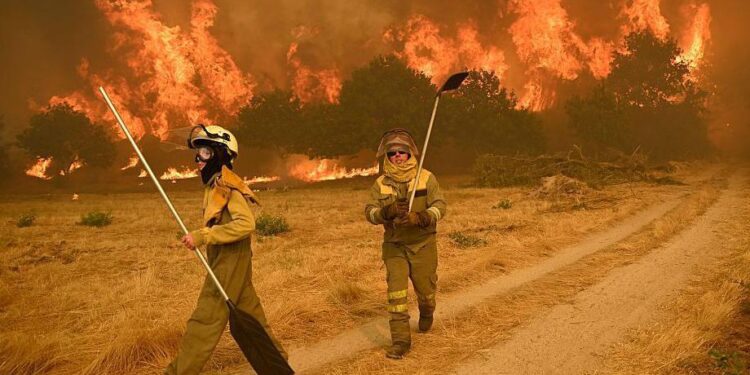Spain is grappling with its most devastating wildfire season since 1994, as recent blazes have scorched a staggering 382,607 hectares of land across the country. The widespread destruction has raised alarm among authorities and environmental experts, highlighting the growing threat of forest fires amid changing climate conditions. This unprecedented level of damage underscores the urgent need for enhanced prevention measures and coordinated response efforts to protect Spain’s natural landscapes and communities.
Spain Faces Unprecedented Wildfire Devastation Impacting Ecosystems and Communities
The recent wildfires in Spain have ravaged an unprecedented 382,607 hectares of land, marking the worst environmental destruction since 1994. These massive fires have swept across multiple regions, severely impacting diverse ecosystems ranging from lush forests to protected wildlife reserves. The aftermath is visible in charred landscapes, threatening the survival of native species and destabilizing ecological balance. Conservationists warn that the recovery could take decades, as vital habitats for flora and fauna have been decimated.
Communities are also bearing the brunt of this disaster, facing mass evacuations, loss of homes, and interrupted livelihoods. The Spanish government has mobilized emergency services and international aid to contain the blazes and support affected populations. Below is a summary of the most affected regions and the extent of vegetation lost:
| Region | Hectares Burned | Primary Impact |
|---|---|---|
| Andalusia | 120,315 | Forest & Agriculture |
| Catalonia | 85,600 | Wildlife Habitat |
| Valencia | 55,450 | Residential & Farmland |
| Castilla-La Mancha | 56,242 | Forest & Grassland |
- Emergency response: Over 4,000 firefighters deployed nationwide.
- Evacuations: More than 12,000 residents displaced.
- Environmental concerns: Increased risk of soil erosion and water contamination.
Analyzing Causes and Response Efforts Behind the Surge in Wildfire Destruction
Multiple factors have converged to fuel the unprecedented wildfire devastation in Spain, resulting in the loss of over 382,000 hectares. Prolonged drought conditions, soaring summer temperatures, and strong winds created the perfect storm for rapid fire spread. Additionally, changes in land use, such as increased forest density and abandoned agricultural fields, have provided ample dry fuel, significantly escalating risks. Experts also cite the delay in early detection and the limitations of outdated firefighting infrastructure as critical hurdles in containing the blazes before they engulfed vast territories.
Response efforts have been multifaceted, involving coordination among regional firefighting units, the national army, and international support teams. Emergency measures include:
- Deployment of aerial fire suppression, including helicopters and fixed-wing aircraft
- Evacuation of vulnerable communities to mitigate casualties
- Mobilization of rapid response ground crews equipped with advanced technology
- Implementation of controlled burns to create firebreaks in high-risk zones
Despite these efforts, challenges remain due to the scale and intensity of the wildfires, prompting authorities to reconsider fire management policies and invest in improved surveillance systems.
| Cause | Impact | Response Strategy |
|---|---|---|
| Drought & Heatwaves | Accelerated fire ignition and spread | Enhanced early warning systems |
| Abandoned Farmland | Increased dry vegetation fuel load | Controlled land clearing |
| Limited Infrastructure | Delayed containment efforts | Investment in new firefighting technology |
Strategic Recommendations for Enhancing Wildfire Prevention and Emergency Preparedness in Spain
In light of the devastating wildfire season, implementing robust land management strategies must become a national priority. This includes expanding controlled burns, promoting native vegetation restoration, and enhancing forest thinning programs to reduce available fuel loads. Local authorities should collaborate with agricultural sectors to incentivize fire-resistant crop planting and establish buffer zones between forested areas and urban developments. Strengthening community-based monitoring systems through technological tools like satellite imagery and AI-powered early detection can drastically improve response times and limit fire spread.
Emergency preparedness also requires comprehensive upgrades to infrastructure and public awareness campaigns. Investments in advanced firefighting equipment, including drones and aerial resources, should be coupled with specialized training programs for first responders. Developing mobile alert platforms tailored to regional dialects and leveraging social media will ensure timely evacuation notices reach vulnerable populations swiftly. A summary of critical recommendations is highlighted below:
- Increase funding for controlled burns and fuel reduction
- Deploy AI-backed early wildfire detection systems
- Enhance cross-sector cooperation for land-use planning
- Upgrade firefighting technology and personnel training
- Implement targeted, multilingual public warning systems
- Develop community-led fire preparedness workshops
| Recommendation | Expected Impact | Timeline |
|---|---|---|
| Controlled Burns Expansion | Reduced fuel loads, lower fire intensity | 1-3 years |
| AI Fire Detection | Faster alerts, improved response | Immediate – 2 years |
| Community Workshops | Higher public readiness, fewer casualties | 6 months – ongoing |
The Conclusion
As Spain confronts its most severe wildfire damage in nearly three decades, the scale of destruction underscores the growing challenges posed by climate change and intensified drought conditions. Authorities continue efforts to control the blazes and support affected communities, while experts urge renewed focus on prevention and sustainable land management to mitigate future risks. The coming weeks will be critical in assessing the full impact and shaping Spain’s response to an increasingly volatile fire season.
















